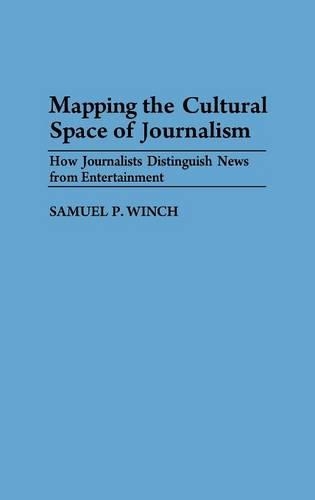
Mapping the Cultural Space of Journalism: How Journalists Distinguish News from Entertainment
(Hardback)
Available Formats
Publishing Details
Mapping the Cultural Space of Journalism: How Journalists Distinguish News from Entertainment
By (Author) Samuel P. Winch
Bloomsbury Publishing PLC
Praeger Publishers Inc
30th April 1997
United States
Classifications
Tertiary Education
Non Fiction
070.195
Physical Properties
Hardback
208
Width 156mm, Height 235mm
454g
Description
Addressing controversial issues of the blurring boundaries between news and entertainment and the movement toward sensationalism in broadcast journalism, this study examines these distinctions: how boundaries are constructed and by whom, how they are enforced or broken and why. Rather than reflecting essential attributes by which news can be distinguished from other kinds of communication, "boundary setting" is viewed as a social construction, determined and changed by journalists wishing to assert their jurisditiction and authority and the prestige of the profession. Four instances of "boundary-work rhetoric" are examined in depth: the development of roles and "rules" of television journalism during the early years of television; attempts at congressional and FTC regulation-broadcasting codes defining "bona fide" news; responses to a 1992 journalistic scandal over a "Dateline NBC" story on exploding GM pickup trucks; and reporting sex scandals during recent political campaigns, such as the allegations of Gennifer Flowers of her involvement with Bill Clinton. In these and other cases, journalists developed strategies to minimize harm to the profession.
Reviews
[T]his book deserves commendation for its careful and historical analysis.-Afterimage
Winch has written a highly personal yet scholarly description of the difference between 'tabloid' and 'mainstream' journalism, i.e., between information that is amusing and information that is important. The boundaries between these heretofore discrete entities have become blurred. Basing this discussion in part on the work of sociologist Thomas Gieryn, the author provides a useful description of how the boundaries are perceived, drawn, and enforced.... Nontraditional media such as the tabloids have been largely ignored by journalism researchers, and this book fills that gap.-Choice
"This book deserves commendation for its careful and historical analysis."-Afterimage
"[T]his book deserves commendation for its careful and historical analysis."-Afterimage
"Winch has written a highly personal yet scholarly description of the difference between 'tabloid' and 'mainstream' journalism, i.e., between information that is amusing and information that is important. The boundaries between these heretofore discrete entities have become blurred. Basing this discussion in part on the work of sociologist Thomas Gieryn, the author provides a useful description of how the boundaries are perceived, drawn, and enforced.... Nontraditional media such as the tabloids have been largely ignored by journalism researchers, and this book fills that gap."-Choice
Author Bio
SAMUEL P. WINCH is Assistant Professor of Journalism at Bowling Green State University in Ohio. His areas of special interest include journalism ethics, visual journalism, and computer-mediated journalism.
